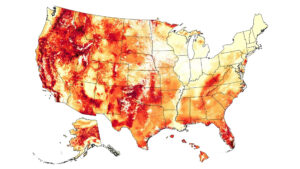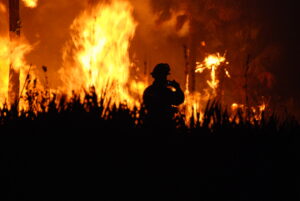A newly updated wildfire risk map could help level the playing field for rural communities who don’t have the resources to conduct their own wildfire risk assessments, according to the independent research group Headwaters Economics.

The map, first created by the U.S. Forest Service under the direction of Congress in 2018, shows wildfire risks at the county level and ways to mitigate those risks. Every U.S. county and tribal area is included in the map.
“With this tool, the data is available for everyone to use, no matter whether you have your own staffing and expertise to produce these kinds of resources or not,” said Kelly Pohl, associate director of Headwaters Economics, in a Daily Yonder interview.
Headwaters Economics was brought on as a partner in the mapping project in 2020. The group made the map’s new updates by incorporating the latest vegetation and climate data, advancements in wildfire hazard simulation modeling, and the most recent building and housing unit information from the Census Bureau.
Wildfire risk is increasing

Better understanding local wildfire risk could be more important for communities than ever because of the map’s recent findings, which shows that about one-third of all Americans live in counties with high wildfire risk.
“There are a lot of states in the East, especially in the Southeast, that have wildfire risk,” Pohl said. “And we do see parts of the country have higher wildfire risk than we previously understood.” Oregon and Washington are two such states, according to Pohl.
In many parts of the country, climate change has caused hotter temperatures and drier conditions. This exacerbates wildfire risk.
Grant opportunities
The Biden administration has implemented several grant programs to better equip communities with wildfire resilience tools in light of this increasing risk.
In February 2024, the administration launched a $5 million pilot program for rural emergency response agencies to convert vehicles to wildland fire engines using slip-on water tank units.
In May 2024, the U.S. Department of Agriculture (USDA) allocated another $250 million to the Community Wildfire Defense Grant Program that supports communities to develop wildfire protection plans and remove vegetation.
The wildfire risk map’s new data underscores the need for the federal government to “continue these efforts through Community Wildfire Defense Grants and our work to increase the pace and scale of hazardous fuels reduction on federal and non-federal lands,” according to USDA’s Forest Service Chief Randy Moore, who was quoted in a press release.
Information about the grant programs and other funding opportunities can be found on the wildfire risk map’s website.
This article first appeared on The Daily Yonder and is republished here under a Creative Commons license. This piece was distributed by the Florida News Connection for the Public News Service.![]()
Sign up for The Invading Sea newsletter by visiting here. If you are interested in submitting an opinion piece to The Invading Sea, email Editor Nathan Crabbe at nc*****@*au.edu.



